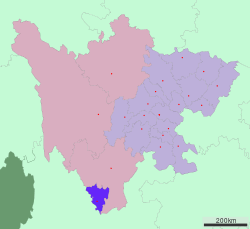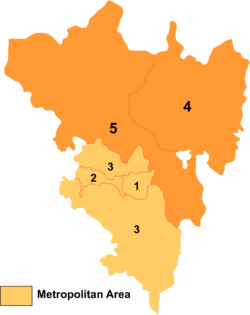Panzhihua
| Panzhihua 攀枝花市 | |
|---|---|
| Prefecture-level city | |
|
Panzhihua | |
 Location of Panzhihua in Sichuan | |
| Coordinates: 26°35′N 101°43′E / 26.583°N 101.717°ECoordinates: 26°35′N 101°43′E / 26.583°N 101.717°E | |
| Country | People's Republic of China |
| Province | Sichuan |
| Municipal seat | Dongqu |
| Area | |
| • Prefecture-level city | 7,423.42 km2 (2,866.20 sq mi) |
| • Urban | 2,010.7 km2 (776.3 sq mi) |
| • Metro | 2,010.7 km2 (776.3 sq mi) |
| Elevation | 1,157 m (3,796 ft) |
| Population (2010 census) | |
| • Prefecture-level city | 1,214,121 |
| • Density | 160/km2 (420/sq mi) |
| • Urban | 787,177 |
| • Urban density | 390/km2 (1,000/sq mi) |
| • Metro | 787,177 |
| • Metro density | 390/km2 (1,000/sq mi) |
| Time zone | China Standard (UTC+8) |
| Postal code | 617000 |
| Area code(s) | 0812 |
| Website | http://www.pzhs.gov.cn/ |
| Panzhihua | |||||||||
| Chinese | 攀枝花 | ||||||||
|---|---|---|---|---|---|---|---|---|---|
| Postal | Panchihhwa | ||||||||
| |||||||||
Panzhihua (Chinese: 攀枝花; pinyin: Pānzhīhūa) is a prefecture-level city located in the far south of Sichuan province, People's Republic of China, at the confluence of the Jinsha and Yalong Rivers. It has an administrative area of 74,423.42 square kilometres (28,735.04 sq mi),[1] and a population at the 2010 census of 1,214,121. 662,814 lived in the metropolitan area made of 3 urban districts.[2]
It is the only city in China named for a flower.[3][4] Its economy relies almost entirely on its giant mine, one of the country's largest. The economy in Panzhihua is mainly centered on natural resource development, exploitation and industry. The city houses many migrants. It is a mountain city. In 2005 Panzhihua won the "China Excellent Tourist City" title, in 2008 it won the "National Health City" and the "China Vanadium, Titanium" titles.
Geography and climate
Ancient cycad forests that were once home to the giant panda are in the area.
The area has a monsoon-influenced humid subtropical climate (Köppen Cwa), with short, mild, dry winters and long, hot, and humid summers. Highs drop to 21 °C (70 °F) in December and January, quickly rebounding during the dry springs, and peak in May and June, unlike much of the rest of the province. Much of the annual rainfall occurs from June to September.
| Climate data for Panzhihua | |||||||||||||
|---|---|---|---|---|---|---|---|---|---|---|---|---|---|
| Month | Jan | Feb | Mar | Apr | May | Jun | Jul | Aug | Sep | Oct | Nov | Dec | Year |
| Record high °C (°F) | 27.9 (82.2) |
32.5 (90.5) |
34.3 (93.7) |
38.0 (100.4) |
39.6 (103.3) |
39.8 (103.6) |
37.9 (100.2) |
38.1 (100.6) |
34.8 (94.6) |
33.5 (92.3) |
29.6 (85.3) |
27.8 (82) |
39.8 (103.6) |
| Average high °C (°F) | 21.8 (71.2) |
24.8 (76.6) |
28.6 (83.5) |
31.7 (89.1) |
32.3 (90.1) |
32.2 (90) |
31.0 (87.8) |
30.6 (87.1) |
28.1 (82.6) |
26.2 (79.2) |
23.4 (74.1) |
21.0 (69.8) |
27.6 (81.8) |
| Daily mean °C (°F) | 13.6 (56.5) |
16.8 (62.2) |
21.0 (69.8) |
24.4 (75.9) |
25.8 (78.4) |
26.3 (79.3) |
25.2 (77.4) |
24.7 (76.5) |
22.4 (72.3) |
20.2 (68.4) |
16.1 (61) |
12.8 (55) |
20.8 (69.4) |
| Average low °C (°F) | 6.9 (44.4) |
9.9 (49.8) |
14.2 (57.6) |
17.7 (63.9) |
19.8 (67.6) |
21.4 (70.5) |
21.3 (70.3) |
20.8 (69.4) |
18.9 (66) |
16.2 (61.2) |
11.3 (52.3) |
7.2 (45) |
15.5 (59.8) |
| Record low °C (°F) | 1.7 (35.1) |
3.6 (38.5) |
6.0 (42.8) |
8.7 (47.7) |
10.5 (50.9) |
13.6 (56.5) |
15.2 (59.4) |
15.6 (60.1) |
10.9 (51.6) |
9.5 (49.1) |
4.1 (39.4) |
0.4 (32.7) |
0.4 (32.7) |
| Average precipitation mm (inches) | 4.2 (0.165) |
3.5 (0.138) |
10.0 (0.394) |
11.7 (0.461) |
45.4 (1.787) |
133.4 (5.252) |
207.1 (8.154) |
210.1 (8.272) |
140.9 (5.547) |
61.2 (2.409) |
20.5 (0.807) |
1.5 (0.059) |
849.5 (33.445) |
| Average precipitation days | 1.5 | 1.6 | 3.3 | 3.1 | 7.9 | 13.8 | 19.2 | 15.4 | 14.6 | 10.2 | 4.3 | 1.3 | 96.2 |
| Source #1: National Meteorological Centre | |||||||||||||
| Source #2: Weather China | |||||||||||||
Hydrology
Panzhihua lies in the Yangtze River basin, holding more than 95 waterways. They feed the Jinsha and Yandalong Rivers, which in turn feed the Yangtze. Annual runoff volume is 110.2 billion cubic meters. The potential hydropower capacity is 700 million kilowatts. The installed capacity is 3.474 million kilowatts.
Geology
Panzhihua is close to the Xigeda-Yuanmou fracture in the Sichuan-Yunnan border.[5] Its Renhe District was the epicenter of the 2008 Panzhihua earthquake.
Archaeology
Bronze Age Bronze Age cultural remains are representative of various types of bronze. Under the jurisdiction of Panzhihua City in Yanbian, Miyi and Renhe District, has collected nearly 20 bronzes. Most of them were tomb sites excavated specifically for funerary objects. They were practical objects that can be divided into three categories. Weapons such as bronze swords, bronze spears, bronze Ge, tools, copper axes, copper knives and copper hoes. Decorative objects include copper bracelets.
The objects were similar to those of western Yunnan province, reflecting ethnic group similarities. The relics date from the Warring States ~ Western Han period.
Tourism resources
The landscape is dominated by natural areas. Attractions include a red cell spa, the Cave Stone Forest, the Jinsha River and Hai lake.
Cycas forest
Cycas first appeared some 280 million years ago in the Permian period. They consist of some 110 species. In 1971, Sichuan Agricultural Science and the original forest vegetation Panzhihua aerial survey, found more than 100,000 specimens. It is the highest altitude cycas forest, hosting the largest number and size of specimens. This forest consists of an endemic species, Cycas panzhihuaensis.
Ertan Hydropower Station
The Ertan Dam (simplified Chinese: 二滩大坝; traditional Chinese: 二灘大壩; pinyin: Èrtān Dàbà) is an arch dam on the Yalong River, a tributary of the Yangtze River in Sichuan Province, southwest China.
The dam has six hydroelectric generators, each with a generating capacity of 550 MW. The total generating capacity of the facility is 3,300 MW, one of the largest in China. Annual production averages 17 TWh, and through December 5, 2006, it produced over 100 TWh of electricity. Construction of the dam started on September 1991 and was completed on December 26, 1999.[6][7] A total of 12,638,000 m3 (446,306,758 cu ft) of material was excavated during construction.
Administrative divisions
| Map | ||||||
|---|---|---|---|---|---|---|
 | ||||||
| # | Name | Hanzi | Hanyu Pinyin | Population (2004 est.) | Area (km²) | Density (/km²) |
| 1 | Dong District | 东区 | Dōngqū | 320,000 | 167 | 1,916 |
| 2 | Xi District | 西区 | Xīqū | 160,000 | 124 | 1,290 |
| 3 | Renhe District | 仁和区 | Rénhé Qū | 200,000 | 1,727 | 116 |
| 4 | Miyi County | 米易县 | Mǐyì Xiàn | 200,000 | 2,153 | 93 |
| 5 | Yanbian County | 盐边县 | Yánbiān Xiàn | 200,000 | 3,269 | 61 |
Economy
Panzhihua is a highly industrialized area dominated by gigantic mining operations. Most of the land not in use for mining is taken up by subsistence farming.
Mineral Resources
Panzhihua has abundant natural resources, but remained a wasteland until 1960. It was founded on a remote headwater of the Yangtze River in 1966 as a steel production center. It grew rapidly as it remained relatively prosperous while the rest of the country suffered under the Cultural Revolution. The city is home to the Panzhihua Iron and Steel (Group) Co, called "Pangang 攀钢", the leading steel company in southwest China.
Proven iron ore (mainly vanadium-titanium magnetite) reserves are 73.8 million tons, 72.3% of the provincial total. At the end of 2007, the city's reserves of vanadium-titanium magnetite were 6.694 billion tons, of which: titanium reserves were 425 million tons, 93% of the national total, the world's largest; vanadium reserves were 10.38 million tons, 63% in the nation, third in the world. Cobalt reserves were 746 million tons. Other minerals were chromium, gallium, scandium, nickel, copper, lead, zinc, manganese, platinum and other rare metals.
| Mineral | Reserves (million tons) |
|---|---|
| Cobalt | 746 |
| Coal | 708 |
| Crystalline graphite | 15.4 |
| Ju Yan | 20.98 |
| Limestone | 295 |
| Metallurgical dolomite | 363 |
| Cement sand retention | 11.94 |
| Refactory clay | 10.32 |
| Diatomite | 16.5 |
| Granite | 87.5 m3 |
| Marble | 53.99 m3 |
Transport
Panzhihua is served by the Chengdu–Kunming Railway and the Panzhihua Bao'anying Airport. The city has over 10 bridges over the Jinsha River.
Education
- Panzhihua University
- The city's top high schools are the No.3 Panzhihua high school (located downtown) and the no.7 high school (located in the western district (Qinxiangping))
References
- ↑ "Nature Resources of Panzhihua" (in Chinese). Official website of Panzhihua Government. Retrieved 2008-08-30.
- ↑ "China: Administrative Division of Sìchuān / 四川省".
- ↑ "Search: kapok". Longdo Dictionary.
- ↑ Wen Chihua (18 January 2010). "Mao statues fashionable again after four decades". China Daily.
- ↑ "Roughly: Part III of emergency response to the M6.1 earthquake at the border of Renhe-Huili, Sichuan: Seismic formation background. (四川攀枝花市仁和区-凉山州会理县交界6.1级地震现场应急工作系列报道之三地震构造背景)" (in Chinese). China Earthquake Administration, CEA (中国地震局门户网). 2008-09-02. Retrieved 2008-09-07.
- ↑ "Ertan Hydropower Plant, Yalong River". Power Technology.
- ↑ "人民日报".
